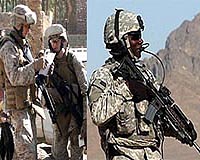| . |  |
. |
Kabul (AFP) May 26, 2009 Afghanistan's top rights body released Tuesday its findings into the disputed casualty toll from US air strikes this month, saying up to 97 civilians, most of them children, may have been killed. Afghanistan's Independent Human Rights Commission (AIHRC) said insurgents involved in the May 4-5 fighting in the southwestern province of Farah had knowingly put civilians at risk but the military had also reacted with too much force. This comes after an Afghan government investigation found that 140 civilians died in the strikes against insurgents, making it one of the deadliest such incidents since the US-led invasion in 2001. A US military investigation has disputed the toll, saying 20-30 civilians may have been killed as well as 60-65 Taliban. The commission said it had sent three investigators to Bala Buluk district a few days after the fighting and they had interviewed witnesses, community elders and aid workers. "AIHRC believes that as many as 97 persons may have been killed in the air strikes, the vast majority civilians," it said in a statement. "Available records suggest that 21 were women and 65 were children, 31 of whom were girls and 34 boys," it said. "Witnesses and other sources reported that the 11 other adult males reported killed in these three compounds were also civilians." Locals had told the commission that between 25 and 30 insurgents were also killed but it was not clear if they died in initial fighting or in the air strikes, the rights watchdog said. President Hamid Karzai demanded a halt in air strikes in Afghanistan after the Bala Buluk killings, saying Afghan civilians should not be harmed in the international war on Islamic extremists being fought here. The US military said it would review its use of such tactics. AIHRC said the hours-long incident had started when 300 insurgents had attacked a series of police checkposts along a key road with the aim of taking control of the route so they could extract tax from any opium traffic. Police called for help from Afghan and international security forces, who soon arrived and fighting raged for several hours. Air bombardments began on two villages in the evening but there were conflicting reports about whether the insurgents were even present at the time, the commission said. "During the bombardment, three houses where civilians had taken shelter were hit," the statement said. The commission said it was continuing its investigation, including into US allegations that the insurgents had used the civilians as "shields". "At a minimum, reports from the villagers suggest that (the insurgents) knowingly, if not deliberately, place civilians at high risk of attack," it said. Nonetheless, "AIHRC believes that the level of force used by pro-government forces, particularly in the follow-up air strikes, was disproportionate." It was also a cause of concern that bombs were even dropped in a populated area, it said. The commission meanwhile raised doubts about the government investigation, saying it appeared to have been conducted in haste. Civilian casualties caused by fighting between international military forces and Taliban-linked insurgents in Afghanistan is perhaps the main source of tension between Kabul and its main ally, Washington. Nearly 2,200 civilians were killed in Afghanistan's conflict last year, according to the United Nations. Thirty-nine percent of the deaths were attributable to pro-government forces, of which nearly two-thirds were from air strikes, it said. Share This Article With Planet Earth
Related Links News From Across The Stans
 US weapons under control in Afghanistan: forces
US weapons under control in Afghanistan: forcesKabul (AFP) May 25, 2009 The Afghan and US militaries Monday played down a report that US-supplied weapons and ammunition were ending up in the hands of Taliban insurgents, saying the munitions were strictly controlled. The New York Times reported last week that ammunition recovered last month from the bodies of insurgents killed in eastern Afghanistan included rounds identical to those supplied by US forces to thei ... read more |
|
| The content herein, unless otherwise known to be public domain, are Copyright 1995-2009 - SpaceDaily. AFP and UPI Wire Stories are copyright Agence France-Presse and United Press International. ESA Portal Reports are copyright European Space Agency. All NASA sourced material is public domain. Additional copyrights may apply in whole or part to other bona fide parties. Advertising does not imply endorsement,agreement or approval of any opinions, statements or information provided by SpaceDaily on any Web page published or hosted by SpaceDaily. Privacy Statement |